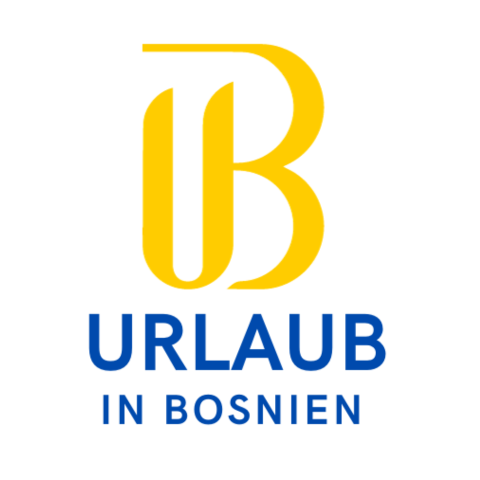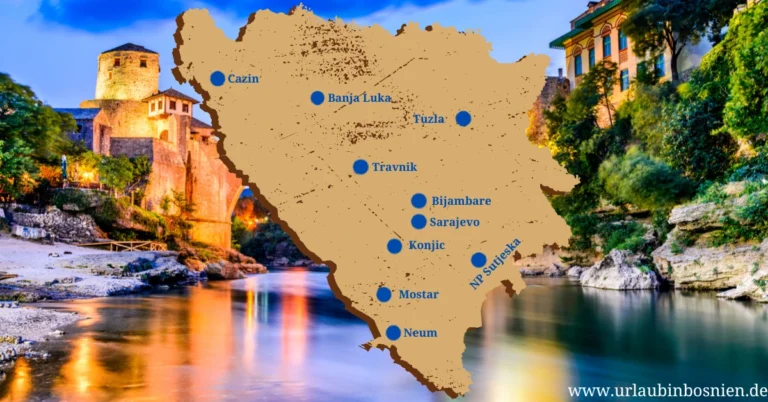Tuzla Bosnia Sights
Join me on a journey to Tuzla Bosnia attractions as we explore this vibrant city together in this post.
The name Tuzla comes from the Turkish word for salt, "tuz," and reflects the city's long history of salt production. Tuzla's salt deposits have played an important role since the Neolithic period. Throughout history, the city has been shaped by various empires, including the Ottomans and the Habsburgs, leaving behind a rich cultural heritage.
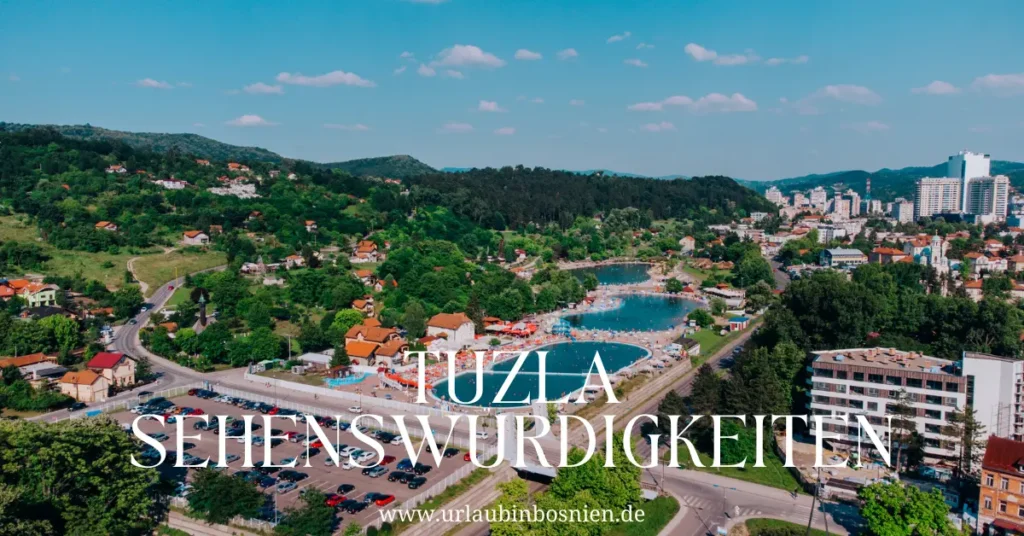
During the Ottoman era, Tuzla flourished as a commercial center. After World War II, the city developed into an industrial center, especially known for its chemical industry. Despite the unrest during the Bosnian War in the 1990s, Tuzla showed remarkable resilience and developed into a city of peace and progress.
In this article I will show you why the Tuzla Bosnia sights are worth a visit and why especially German tourists are attracted to this city.
Why Tuzla inspires German tourists
- Historical and cultural connections
The Habsburg influence in Tuzla's architecture and culture offers a familiar yet fascinating perspective to German visitors. Exploring these Tuzla Bosnia attractions creates a special connection to shared European history. - Affordable travel destination
Compared to other European cities, Tuzla offers excellent value for money. German tourists can enjoy high-quality accommodation, restaurants and attractions at a fraction of the cost they would spend in Western Europe. - Direct and comfortable flights
Thanks to low-cost airlines offering direct flights from major German cities, Tuzla is easy and inexpensive to reach. This convenience makes the city an attractive destination for short trips or longer stays. - Unique experiences
From the salt lakes to the local cuisine, Tuzla offers experiences that are both new and authentic. German tourists can enjoy activities that stand out from the typical European tourist spots, such as swimming in saline lakes or sampling local specialties like Ćevapi and burek. - Warm hospitality
The friendly and welcoming people of Tuzla make visitors feel at home. The manageable size of the city compared to other tourist hotspots allows German tourists a more personal and intimate travel experience. - Extensive event calendar
Cultural festivals in Tuzla, such as the Tuzla Film Festival and the Kaleidoscope Festival, offer German tourists the opportunity to immerse themselves in the local art scene. These events often attract international participants and create a cosmopolitan, yet distinctly Bosnian atmosphere.
Costs for German tourists
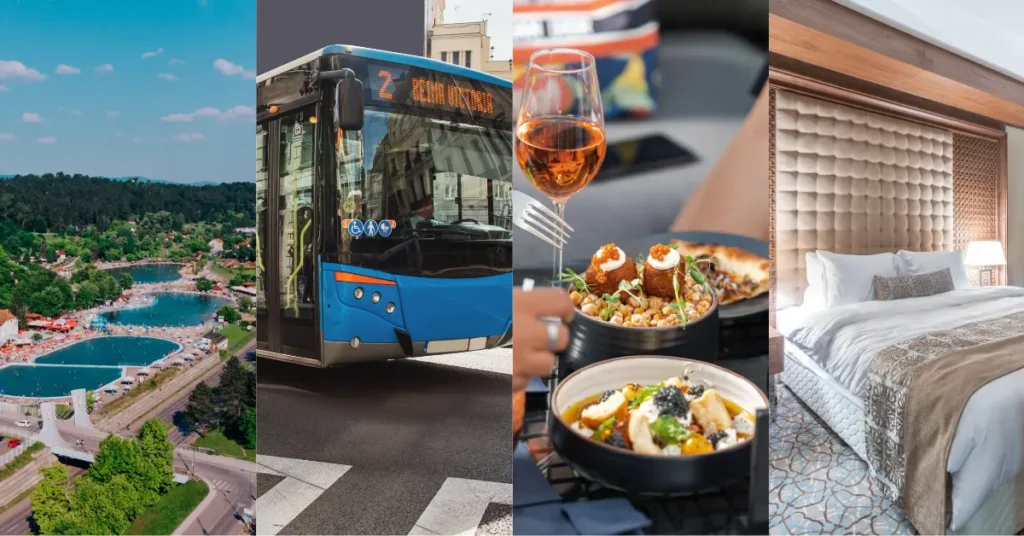
Tuzla is an affordable destination for German visitors. Here is an overview of typical costs while exploring Tuzla Bosnia attractions:
- Accommodation: Budget hotels and guesthouses cost between €20 and €40 per night. Mid-range hotels are between €50 and €80, while luxury accommodation costs around €100.
- Eat: In local restaurants, hearty meals cost €5–10. A three-course meal in a mid-range restaurant is around €15–20.
- transport: Public buses are very cheap, with a fare of around €1.50. Taxis cost an average of €5 for most journeys within the city.
- attractions: The entrance fee to most attractions is low. For example, a day pass for the Pannonian Lakes costs around €3-5.
- currency and exchange: The local currency is the Bosnian Convertible Mark (BAM). 1 Euro is equivalent to about 2 BAM, which makes it easier for German travelers to calculate costs.
If you need accommodation or a guided tour, be sure to visit this part of our websitewhere you can find all this.
Modern Tuzla Bosnia Sights: A City of Salt and Surprises
Tuzla Bosnia attractions include not only cultural events but also many restaurants that offer the unique taste of Bosnian cuisine. Here are some of the main places to visit:
Pannonian Lakes
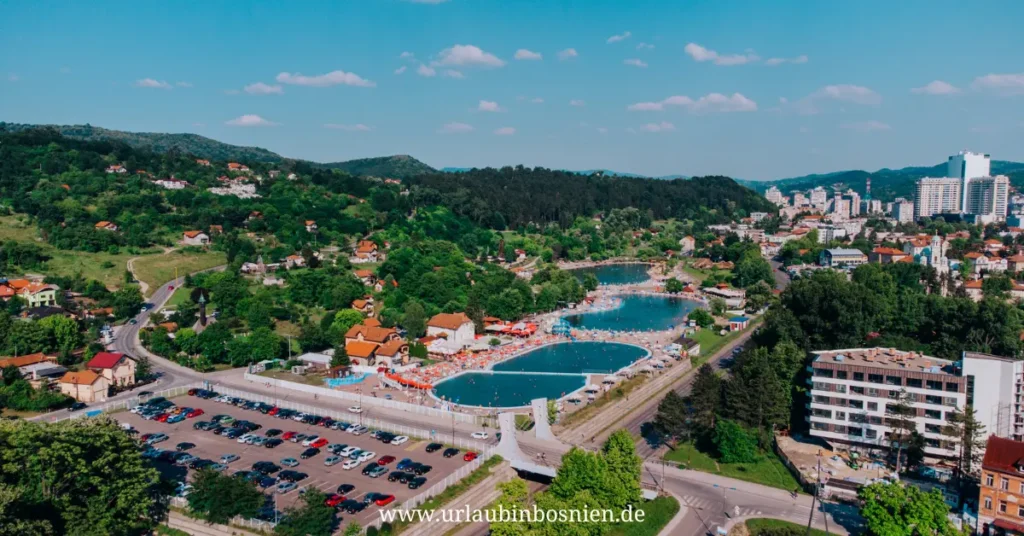
An urban oasis, these artificial salt lakes pay homage to Tuzla's saline heritage. Ideal for swimming and sunbathing, they offer a unique experience compared to traditional freshwater lakes. Tuzla is the only city in Europe with salt lakes and the only city in the world where these salt lakes, a bathing area and a beach are located right in the city center.
Millions of years ago, when the Pannonian Sea left behind much of Europe, huge salt and saline water deposits were left beneath Tuzla. Thanks to this natural wealth and the expertise of local specialists, the first Pannonian Lake was created in 2003 and the second Pannonian Lake in 2008.
The lakes contain mineral-rich salt water extracted from underground salt springs. In addition to bathing fun, the water is known for its healing properties, especially for treating infertility, rheumatism and respiratory diseases. The Pannonian Lakes cover an area of about 17,000 square meters, with beaches of 1,000 meters and a developed space of 60,000 square meters. The salinity of the water is equivalent to that of sea water, ranging between 30 and 40 grams per liter, which offers exceptional therapeutic benefits.
Within the complex there are well-maintained areas for children's entertainment as well as fitness facilities. Over the last four years, around 2 million tourists have visited the Panonika area.
The entire area is open all year round and is well maintained so that visitors can walk and relax there. Within the complex there is a modern outdoor fitness center at the first Pannonian Lake, a street workout park at the third Pannonian Lake, a giant chess set at the first lake and marked trails for walking and jogging throughout the area.
Right next to the complex is the Slana Banja-Vrtić children's amusement park, which is equipped with play equipment for children aged three to twelve years. This unique park has around a kilometer of paved paths and various play equipment, including slides, swings, carousels, seesaws, playhouses, a pirate ship and benches for parents to rest.
Winter attractions in the Panonika complex
JKP “Pannonica” doo Tuzla remains active in the winter season. In cooperation with the City of Tuzla, the first ice skating rink in Tuzla was opened in December 2006. The complex includes a covered ice rink with an area of 660 square meters, which can accommodate over 100 skaters at the same time. Since December 2019, there is a smaller ice rink next to the larger one, designed especially for small children and beginners.
The ice rink is open from late November to early February, depending on weather conditions. In addition to regular ice skating sessions, it offers various entertainment events, activities and an ice skating school.
Kapija Square
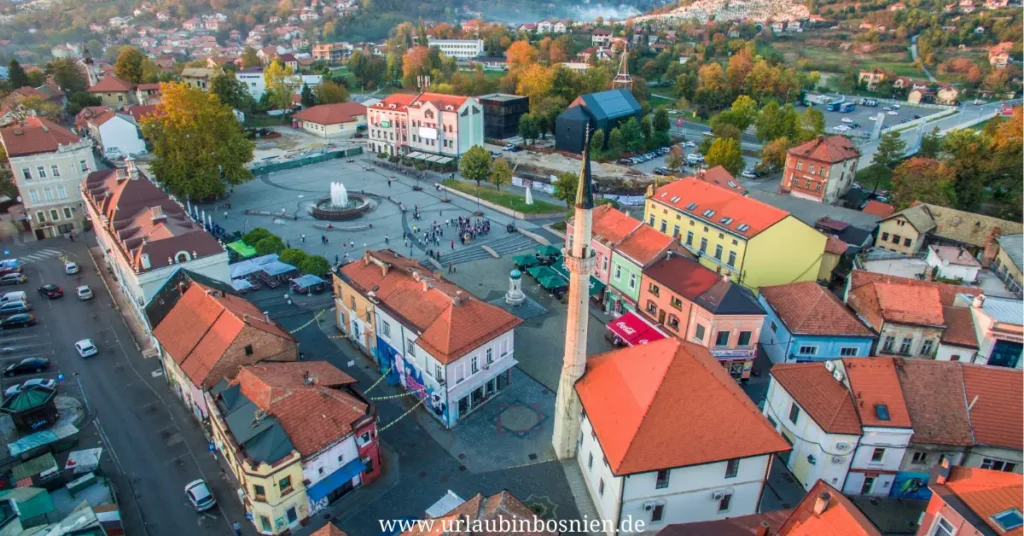
A central location that commemorates those who lost their lives during the war, this square is a powerful symbol of Tuzla's resilience. At the same time, it is a lively area with street performers and local vendors creating a dynamic atmosphere and enriching the historical significance of the square.
salt square and salt well
These landmarks are among the most important Tuzla Bosnia attractions and celebrate the city's historical connection to salt production. The square is often the setting for cultural events and markets where visitors can purchase local handicrafts and traditional foods. The nearby museum offers an insightful look into the history of salt mining in the region.
The city's tourist offers have been enriched by the development of Soni trg (Salt Square) as a museum and tourist complex. During the Ottoman period, this place was used for salt production, and today the remains of the main salt well from that era have been preserved and are open to visitors.
In the heart of Soni trg there is a fountain, a gift from the city of Ravenna. This fountain is in the shape of a stylized Neolithic vessel used for salt extraction and is decorated with a mosaic designed by the Instituto d'arte Severini and the renowned mosaic artist Felice Nittola.
In granite on the Soni trg are engraved the words:
"Tuzla is one of the oldest settlements in Europe. For seven thousand years, from the Neolithic period to the present day, people have produced salt and lived here. The citizens of Tuzla renovated the Soni trg in 2004 in the belief that love is the source of the world's creation and eternal existence."
The square also features a replica of the Neolithic salt-making vessel, which is an integral part of the fountain and is decorated with a mosaic from Ravenna, the world capital of mosaic art. Visitors can also view a museum exhibition that displays artifacts from the Neolithic and other historical periods discovered in and around Tuzla.
Soni trg was once the central commercial centre around which numerous religious and public buildings were built. Today it remains the centre of the historical part of the city, surrounded by dozens of narrow, granite-paved streets, always full of life and youthful energy.
National Theater
The National Theatre is one of the Tuzla Bosnia Sights, which represent a cultural cornerstone of the city. From traditional Bosnian plays to modern performances, the theater offers a varied program that appeals to all tastes. It is an excellent way to immerse yourself in the local art scene.
Tuzla City Park

A tranquil place to relax, the park is decorated with numerous sculptures and offers a peaceful retreat away from the hustle and bustle of the city. The park is a popular spot for morning jogs and evening strolls. There are plenty of benches to sit on to enjoy the green surroundings. The park also has a children's playground and a small cafe, making it a family-friendly destination.
Slana Banja Complex

Not far from the Pannonian Lakes is the Slana Banja complex – an ideal place for walks, to escape the hustle and bustle of the city and enjoy the fresh air of the nearby forest.
Slana Banja offers a long walking path. At the beginning of the path is the restored Leda fountain, designed by Tuzla artist Franjo Leder. In the center of the fountain is a figure of Leda, symbolizing Franjo's unrequited love, surrounded by swans, which are believed to embody the vision of his passion.
Continuing the path, gently uphill, you will come across the communal cemetery and memorial plaques for the victims of the Kapija massacre on the left, followed by memorial plaques dedicated to fallen soldiers of World War II. At the very top of Slana Banja stands a large statue of Marshal Tito, surrounded by statues of prominent partisans.
This recreational area includes walking paths, sports facilities and memorial sites. It is a great place for outdoor activities and offers the opportunity to learn more about Tuzla's history through the well-maintained monuments.
Kicelj viewing platform

On the Kicelj Hill there is a beautiful viewpoint that offers a breathtaking panoramic view of the city and is one of the Tuzla Bosnia Sights as well as a popular retreat for locals. This spot is particularly ideal at night when the illuminated heart sculpture creates a charming atmosphere. Clearly marked signs lead you to the viewing point, where a plaque describes the site as an early medieval necropolis, adding a touch of historical intrigue to your visit.
On the plateau you will find a 3D heart with LED lighting, which makes the place even more attractive for visitors and becomes a popular destination for beautiful photos of Tuzla. The viewpoint offers a wide view of the city, making it a perfect place for relaxation and photography.
Religious Tuzla Bosnia Sights
In Tuzla, you can see the rich Islamic tradition in several historic and beautifully preserved mosques. They include the Poljska (Turalibegova) Mosque, built in 1572, as well as the Šarena, Čaršijska, Džindijska, Mejdanska and the White Mosque in Gornja Tuzla. In addition, the Čaršijska Fountain, dating back to 1888, is a notable landmark.
The Roman Catholic Church of St. Peter, originally built in 1873 and decorated with valuable frescoes, had to be demolished in 1987 due to subsidence caused by salt mining. In its place, the new Franciscan monastery and the Church of St. Peter and Paul were built in 1998. Nearby, the Serbian Orthodox Church of the Assumption of the Blessed Virgin, dating to 1874, was successfully saved from subsidence in the 1980s, despite being located in an area with the same geological problems.
This Tuzla Bosnia Sights are a testament to the diverse religious heritage and resilience of this city and offer you the opportunity to explore its rich cultural and spiritual history.
Where to eat in Tuzla?
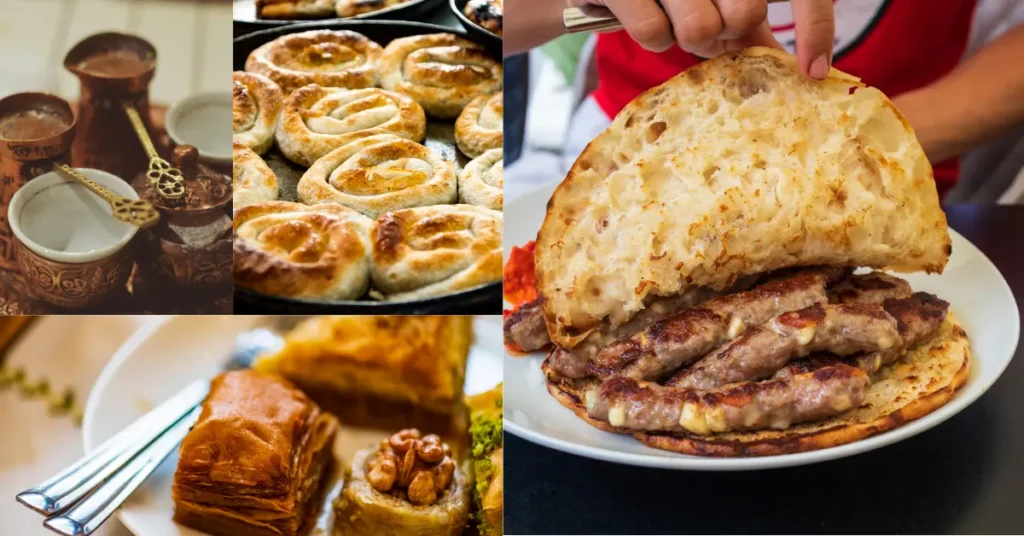
Here is a selection of restaurants in Tuzla, each offering a unique culinary experience:
Ćevabdžinica Zlaja Slatina
Located in Slatina, this restaurant is known for its delicious Ćevapi. Guests often rave about the quality of the food and the relaxed atmosphere, making it a must-visit for a real taste of Tuzla.
Restoran Sedra
Another restaurant in Slatina worth visiting is Sedra. It offers a varied menu of Bosnian dishes, pizzas and doner kebab. With a seating capacity for 150 guests indoors and an additional 30 outdoors, it is ideal for both summer and winter dining.
City Steak House
Located on the 16th floor in Sjenjak, City Steak House offers panoramic views of Tuzla and a menu that combines local and international cuisines. It is the perfect venue for special occasions with a VIP lounge and catering services.
Restoran Favoris
Favoris is characterized by its charming interior and an innovative menu that includes international delicacies and a fine selection of wines. It is open daily from 7:00 a.m. to 10:00 p.m. and offers a cozy place for meals and relaxation.
Restoran Royal
Located in the Motel Royal, this restaurant offers a mix of Mediterranean and international cuisine. With live music performances in the evenings, it's a great place for a relaxed dinner or business lunch.
Ćevabdžinica Limenka
A fixture in Tuzla since 1967, Limenka is known for its Ćevapi. Located near the Pannonian Lakes and the city park, Limenka is a popular spot for both locals and tourists.
Restoran Terminal
Located in the Irac district, this restaurant is famous for its gourmet dishes and impeccable service. Its modern interior makes it a preferred place for romantic dinners, family gatherings and business lunches.
Čaršijska Česma
This restaurant offers a traditional Bosnian dining experience with classic dishes and a historically themed interior. Located near Trg Slobode, it serves as a cultural and culinary landmark in Tuzla.
Restoran Zlatnik
Zlatnik combines an elegant ambience with a diverse menu of both local and international cuisines. Its location near the Slana Banja promenade makes it a pleasant place for a meal after a leisurely stroll.
Palačinkara kod Bagija
For those with a sweet tooth, Palačinkara kod Bagija near the city park offers a wide selection of delicious pancakes, each with unique toppings such as Kinder chocolate and ice cream.
Each of these restaurants offers a unique taste of Tuzla, whether you are looking for traditional flavors or modern culinary delights.
